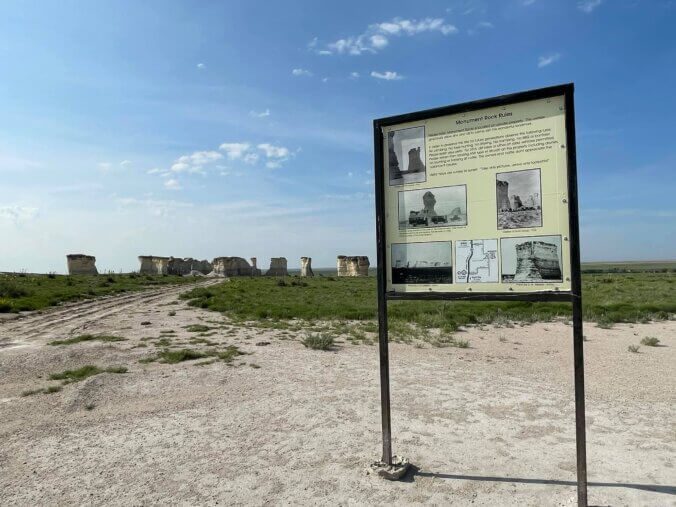The History
Monument Rocks is famous for its towering chalk formations, which resemble massive pillars rising from the prairie. Millions of years ago, a vast inland sea submerged the region and deposited sedimentary layers that formed these majestic structures. Over time, erosion sculpted the rocks into their current awe-inspiring shapes, leaving behind an almost otherworldly landscape. Standing before these towering monoliths, one can’t help but feel humbled by the vastness of geological time. Beyond their geological significance, Monument Rocks also harbor a rich history.
This area was once part of the Great Western Cattle Trail, a pathway that facilitated the movement of cattle from Texas to the railheads in Kansas during the late 19th century. Imagine the countless cowboys who traversed these lands, their presence forever etched into the annals of American history. As you wander amidst the rocks, you may reflect upon the past and contemplate the lives of those who came before.
While Monument Rocks is primarily known for its geological features, the surrounding prairie ecosystem supports diverse wildlife. Nature enthusiasts will relish spotting various bird species, including soaring hawks and graceful owls. Mammals such as deer, pronghorn antelope, and coyotes can also be observed, each adding to the vibrancy of this natural habitat. Exploring the monument offers a chance to reconnect with nature and appreciate the delicate balance of life within its boundaries. Recognizing the exceptional value of Monument Rocks, it was designated a National Natural Landmark in 1968, ensuring its protection and preservation for future generations. The U.S. Bureau of Land Management oversees the site, implementing measures to maintain its ecological integrity while allowing visitors to experience its wonders responsibly. As visitors, it is our responsibility to respect and care for this unique natural treasure, leaving behind only footprints and taking away memories that will last a lifetime.
Visiting Monument Rocks is an adventure that captivates the young and the old. Guided tours and interpretive signage provide valuable insights into the area’s geology, history, and ecology. While no visitor facilities are on site, the nearby town of Oakley offers amenities such as accommodations, dining, and information centers to enhance your experience. Remember to pack water, sun protection, and sturdy shoes, as the Kansas weather can be unpredictable and the terrain uneven. Before heading into the vast prairie, ensure to fill up on gas and water.
The drive from Oakley and Scott City to the monument is roughly thirty minutes. I will warn you there is NOTHING out there other than the monument. The vast, wide open spaces will have you wondering how the folks made it to Oregon all those years ago. Oakley will be the most traveled through of the two cities as it is off of I-70 and will provide the most amenities for you, while Scott City sits on Highway 96. While it is a nice two-lane, sometimes 4 lane highway, it is not as frequently traveled as I-70.
Know Before You Go
- Region: Western Kansas
- Location: 38.79568325740451, -100.76413726069063
- There are no maintained facilities at the location. Ensure you have enough water and gas to reach the nearest towns. Also, check distances, maps, and weather before venturing out.
- Coordinates: 35.11757984304067, -111.09648062915922
- Costs: No Fees or Permits are Required
- Schedule: Open 24 hours
- Attraction Type: National Historic Site
- Additional Resources: Travel Kansas
My Visit
This particular landmark was not one that I had planned on visiting during my drive to meet my friend, Brandon, in Colorado near the New Mexico border for some Jeep adventures. I camped at a fantastic Hipcamp campsite called the C2 Ranch on the Saline River. I highly recommend the location, and the hosts were fantastic. The hosts suggested that since I was not headed out to Denver or Colorado Springs to work my way south from their place, they gave me some great places to stop and check out and mentioned the monument was not that far away. There were several other historical landmarks in the area as well. My adventurous spirit gave way, with some time to kill before meeting my friend a day later. I left camp that next morning, searching for giant pillars in the prairie.
I had driven many times across Kansas, mostly on I-70, which, if you talk to anyone, they say is just as bad and boring as I-80 is across Nebraska, which I can agree with. Long, boring, empty, and seems to take forever. This was my first time truly wandering around the western part of Kansas with no real destination other than, at some point, meeting my friend in south-central Colorado.
Monument Rocks National Monument was a nice stop that allowed for walking around and enjoying the vastness of the prairie and wondering why anyone would want to live out here. Then I remembered life in Arizona and thought, at least there is water out here. I would suggest stopping if you are ever in the area.






















